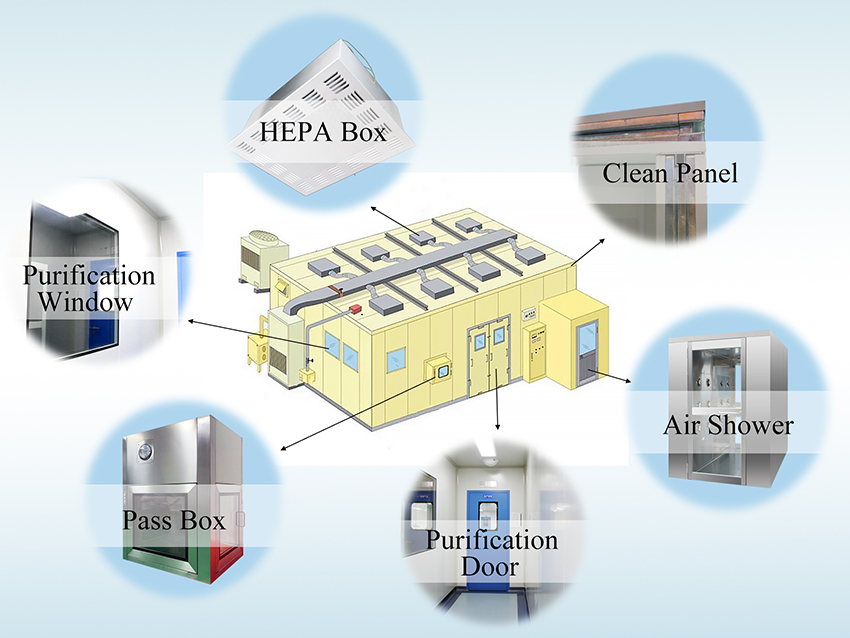1.What is clean room:
A clean room refers to a controlled environment in which the airborne particles or other pollutants are restricted from introduction, gathering, generation, and retention, and in which other relevant parameters, e.g. temperature, humidity, airflow and noise, are controlled as necessary. It is widely used in electronics, semiconductors, optical devices, medicine, food and other industries.

2. How does clean room remain clean:
(1) The clean room works to dilute and remove airborne particles, bacteria and other chemicals through sufficient amount of high-efficiency filters, and regulates the air pressure to ensure pollution-free circulation within the room.
(2) Construction materials are non-pollution and easy to clean. They do not generate particles or other chemicals on their own.
(3) Operators must wear prescribed garments to minimize contamination of particles or microbes from human bodies (hair, skin, etc.).
3. The working system of clean room:
Airflow → Primary purification → Humidification → Heating → Surface cooling → Medium purification → Air blower → Duct → High-efficiency purification → Blowing into the room → Taking away dust, bacteria and other particles → Return air shutters → Primary purification
Repeat the process above to achieve the purification.
4. The types of clean room:
·Based on the airflow, there are mainly four types of clean rooms:
(1)Unidirectional Airflow Clean Room, also called laminar flow clean room, can be divided into vertical and horizontal flow clean rooms. The airflow in it sweeps through in a unidirectional way along parallel lines at a uniform velocity throughout the whole room under the ceiling. Just like a “piston”squeezing the air, the contaminants will be removed back into air ducts rapidly.
Unidirectional airflow clean rooms are excellent in purification, with cleanliness levels of ISO 5 or even lower. As a result of much more air supply than non unidirectional airflow clean rooms, it is more expensive in construction and operation.
(2)Non Unidirectional Airflow Clean Room, originally known as turbulently ventilated clean room. In this room, the air does not flow in a unidirectional way or along parallel lines, however, appearing reflux or vortex. The fresh air generated can continuously dilute room air and remove contaminants gradually, so as to achieve cleanliness.
Non unidirectional airflow clean rooms are general in purification respectively, with cleanliness levels about ISO 8. Sometimes it can reach ISO 6 at best in some industries or small clean rooms.
(3) Radiation Flow Clean Room, also called vector clean room. In this room, supply air outlets are installed in the upper corner of the side and return air outlets in another corner. The clean air flows diagonally down to the outlets along radial lines, pushing contaminants into outlets and finally out of room.
Under same cleanliness needs, radiation flow clean room requires less air supply, so the energy can be saved significantly, with cleanliness level up to ISO5, which is better than non unidirectional flow clean room. The ratio of height to length is generally recommended from 0.5 to 1.
(4)Mixed Flow Clean Room, often uses non unidirectional airflow for the whole room, but unidirectional airflow for stringent area in cleanliness, thus the relatively poor air can be prevented from high cleanliness area.
Mixed flow clean room minimizes unidirectional airflow by non unidirectional airflow replacement so as to reduce initial investment and running costs.
·Based on particles controlled, there are mainly two types of clean room:
(1)Industrial Clean Room: The controlled particles are abiotic(e.g. dust).
(2)Biological Clean Room:The controlled particles are microbial(e.g. bacteria) and abiotic. It can be further divided into:
*General Biological Clean Room
It mainly controls the contamination to microbial particle subjects. Its internal materials should be tolerated to the erosion of various sterilizing agents and space maintained a positive pressure with the atmosphere.
*Bio-safety Clean Room
It mainly controls the contamination from microbial particles in subjects to external environment and people. Its internal space maintains a negative pressure with atmosphere.
Contact: Suzhou Dongri Purification Technology Co., Ltd.
Phone: +86-17751260306
Tel: +86-512-63337738
Email: sales2@dongritc.com
Add: No.499 Jin sheng Road,Jinjiaba,Wujiang District,Suzhou City,Jiangsu Province
We chat
